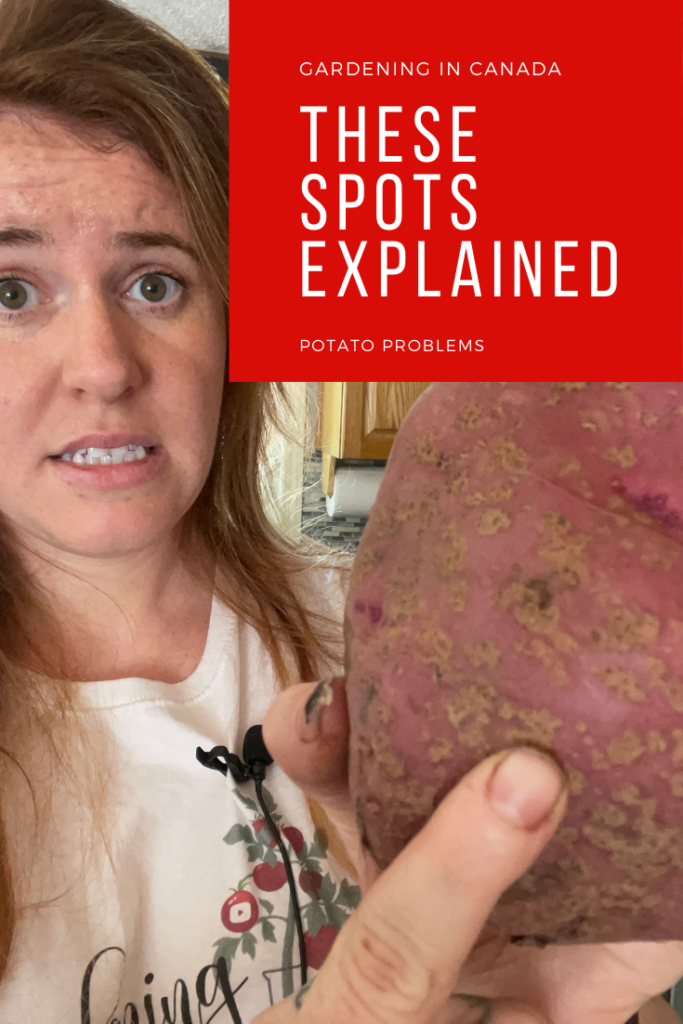- Canada’s Growing Zones Are Changing 2024 - January 12, 2024
- Attracting Wildlife To The Garden - May 16, 2023
- How To Garden Near A Septic Tank - May 9, 2023
Lenticel spot on potatoes is a common problem that can be frustrating for gardeners. It’s characterized by dark, sunken lesions on the skin of the potato, which can make the potatoes less appealing and potentially shorten their storage life. But what causes lenticel spot, and is there anything you can do to prevent it?
If you are new to this blog my name is Ashley and I am a soil scientist. I am located in a Canadian Zone 3 and a USDA Zone 4. I write articles, make YouTube videos, Instagram & Facebook posts all designed for Canadians and Cold Climate gardeners using science-based methods. If you are looking for anything specific be sure to let me know in the comments down below.
What Are Lenticels?
First of all, it’s important to understand what lenticels are. These are small, porous openings on the surface of the potato that allow for gas exchange. They’re essential for the plant’s health, but they can also be a point of weakness. If bacteria enter through the lenticels, it can lead to the development of lenticel spot.
What Causes These Spots On Potatoes?
There are several factors that can increase the risk of lenticel spot on potatoes. Environmental stress, such as drought or extreme temperatures, can make the plants more vulnerable to infection. Similarly, the presence of bacteria in the soil can also increase the risk of lenticel spot. Cultural practices, such as improper fertilization or overwatering, can also contribute to the development of the disorder.
Prevention Of Lenticel Spots On Potatoes
So, what can you do to prevent lenticel spot on your potatoes? One of the most effective ways is to practice good crop rotation. This helps to reduce the accumulation of bacteria in the soil and can lower the risk of lenticel spot. Proper fertilization and watering practices can also help to prevent the disorder, as can using resistant varieties of potato.
How Do These Potato Blotches Affect Storage?
It’s important to note that while lenticel spot can affect the appearance and storage life of your potatoes, it doesn’t affect their edibility. The potatoes are still safe to eat, so don’t let lenticel spot discourage you from enjoying your homegrown spuds.
To minimize the risk of decay, it’s important to store your potatoes in a cool, dry place. If you do notice any infected potatoes, be sure to remove them from the storage bin as soon as possible to prevent the infection from spreading.
What Does Science Say About Lenticle Spot?
There have been several scientific studies that have looked into the best ways to prevent lenticel spot on potatoes. For example, a study published in the journal Plant Pathology found that the use of resistant varieties and proper fertilization practices can be effective in reducing the incidence of lenticel spot (Hudson et al., 2002). Another study, published in the Journal of the American Society for Horticultural Science, found that the use of mulch and the application of organic amendments, such as compost, can also help to prevent lenticel spot (Barequet et al., 2003).
What are the top ways to prevent potato spotting:
- Practice good crop rotation: This can help to reduce the accumulation of bacteria in the soil and lower the risk of lenticel spot.
- Use proper fertilization and watering practices: These cultural practices can help to prevent the development of lenticel spot.
- Consider using resistant varieties of potato: These varieties may be less prone to lenticel spot.
- Store potatoes in a cool, dry place: This can help to extend their storage life and minimize the risk of decay.
- Remove infected potatoes from the storage bin as soon as possible: This can help to prevent the infection from spreading.
- Consider using mulch and organic amendments: These may help to prevent lenticel spot, according to some studies.
In conclusion, lenticel spot is a common problem that can affect potato plants, but there are steps you can take to prevent it. Good crop rotation, proper fertilization and watering practices, and the use of resistant varieties can all help to reduce the risk of lenticel spot. While the presence of lenticel spot can affect the appearance and storage life of your potatoes, it doesn’t affect their edibility, so don’t be afraid to enjoy your homegrown spuds.
References:
Barequet, G., Cohen, D., Riov, J., & Daus, A. (2003). Effect of mulch and organic amendments on lenticel spot of potato. Journal of the American Society for Horticultural Science, 128(2), 235-240.
Hudson, N. L., Plaisted, R. L., & Hausbeck, M. K. (2002). Factors influencing the incidence of lenticel spot on potato in Michigan. Plant Pathology, 51(3), 301-310.

